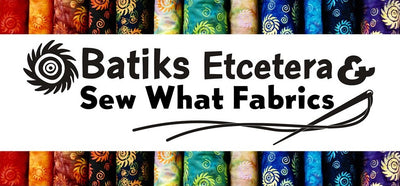How to Wash Batiks and Set Dyes

Batiks Etcetera & Sew What Fabrics specializes in Indonesian and Malaysian batiks. We find they are the highest quality of dyes, prints(tjaps), and base cloth. We find these fabrics bleed less, lose color less, and respond best to quilting, dressmaking, and home decor. The Indonesian and Malaysian batiks are mostly dyed with fiber reactive Procion dyes which are dyes hand dyers in the US prefer. The colors are permanent and brilliant.
Indian batiks are lovely but like madras most bleed. It is a different look but one I found is more trouble than most people want to deal with.
In making a batik with a design or a tjap that has been stamped on the fabric with wax, very hot water is used to remove the wax. That also sets the colors, shrinks the fabric, and removes excess dye. The last color may or may not have been followed by the hot water treatment. But the dye (if procion) is inert and will not dye other fabrics.
If the batik does not have a design there may be excess dye that should be removed before using the fabric in a project. We call these designs "almost solid batik" or "multi colored batik". This would be like the many handpainted batiks that are made by Hoffman, Benartex, Island, Timeless, Kaufman and others. I find there is usually some excess dye in these.
So what do you do? I prewash all fabrics including batiks. I usually sort my fabrics by light and dark. I use Retayne and hot (140 degree) water and follow the instructions. I find this removes any wax that may still be in the fabric as well as excess dye.
A lot of people do not prewash any of their fabrics. If it is a wallhanging that will not get hot cocoa on it, I'm fine with that. But quilts, I want to be able to wash. If I don't want to prewash, I test my suspect fabrics by cutting an inch square, putting it in hot water, and microwaving it on high. I let it cool. If the water is highly colored, I prewash that piece of fabric and set the dye with Retayne. I often will have 6-8 little pyrex bowls brewing to check fabrics.
Copyright Carol Britt 2007

